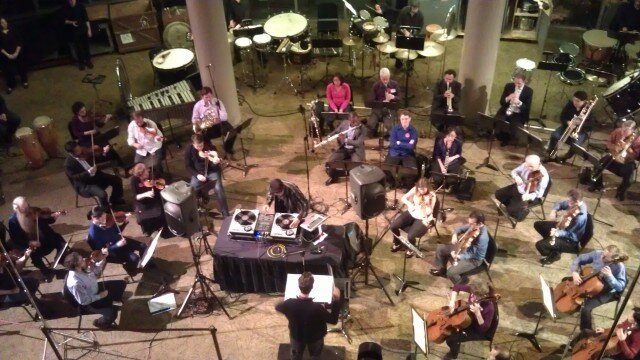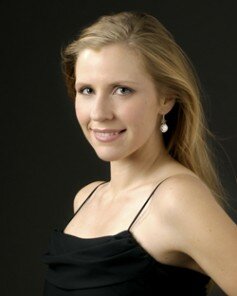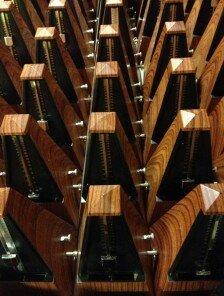
A buzzing crowd packed Benaroya Hall’s Grand Lobby on Friday night for the first concert in the Seattle Symphony‘s new [untitled] concert series. These late-night, casual concerts present 20th century and contemporary classical music in a salon-style format complete with drinks, floor cushions, and mingling with the musicians. It’s difficult to imagine that many people would choose an edgy program of esoteric, rarely-performed classical music over the myriad of competing arts events this past weekend. (City Arts Fest, anyone?) Yet tickets for Friday’s performance sold out, filling the Grand Lobby’s floor and balconies with an audience that included white-haired symphony fans, bearded hipsters, and young couples.
Friday’s concert focused on 1962, featuring small-ensemble works composed in that year. 20th century greats John Cage, Giacinto Scelsi, Earle Brown, Iannis Xenakis, Morton Feldman, and György Ligeti were represented, making the program a veritable who’s-who of modern classical music. For the uninitiated, this provided an excellent overview of 20th century composers and compositional styles. There was plenty for the experienced listener as well, including a riveting performance of Scelsi’s challenging ensemble piece Khoom and an opportunity to experience the spectacle of Ligeti’s Poème symphonique for 100 Metronomes.
Seattle Symphony Music Director Ludovic Morlot served as emcee for the evening, and conducted most of the works on the program. He was joined by a host of musicians, including the Symphony’s new Assistant Conductor Stilian Kirov, local soprano Maria Mannisto, and members of the New York-based International Contemporary Ensemble (ICE). Gabriel Prokofiev, grandson of the legendary Sergei Prokofiev, was on hand for a pre-concert performance of his Concerto for Turntables and Orchestra, featuring local DJ Darek Mazzone.
A sizable crowd gathered in the Grand Lobby to experience Prokofiev’s piece, which bridged the hour-long gap between the Symphony’s regular evening performance and the late-night [untitled] program. A mind-blowing visual and auditory spectacle, the work is written in standard classical concerto form with the DJ and turntables taking over the role of the instrumental soloist. Similar to a traditional concerto, the piece demonstrates the virtuosity and versatility of the soloist. In this case, Prokofiev’s writing shows off the DJ’s prowess at generating complex beats, scratches, melodies, and layers of sound. A camera next to the turntables broadcasted the action onto screens around the auditorium.

Unlike acoustic instruments, the turntables possess the ability to record and remix. The highlights of the performance involved remixing on the fly, especially sections where Mazzone recorded the full orchestra playing a passage, remixed it, and replayed it as accompaniment for the ensemble. Written in 2007, Prokofiev’s thoroughly contemporary piece didn’t mesh with the 1962 theme of the rest of the evening, but it should have been included as part of the regular concert program. I suspect many [untitled] ticketholders didn’t know about the pre-performance and missed out on this spectacular 21st century work.
Despite the evening’s casual atmosphere, the 1962 program was filled with examples of masterful technique and musicality. Acclaimed local soprano Maria Mannisto joined the ensemble for a performance of Scelsi’s Khoom, written for string quartet, French horn, soprano voice, and percussion. This seven-movement work features challenging, nuanced writing, especially for voice and horn. Mannisto’s performance was spellbinding, particularly in a powerful duet with ICE horn player David Byrd-Marrow. In this movement, horn and voice blended and echoed each other, generating sounds that simultaneously evoked primitive and futuristic themes.
Another standout moment of the evening was the performance of Xenakis’ Atrées. Xenakis’ mathematical approach to composition often generated works that resemble giant musical Katamari balls, with random sounds sticking out here and there. Atrées is no exception. This blob of discrete sounds brilliantly manages to adhere together into a coherent work, often with the help of prominent glissandos in the cello and trombone. These were performed with great aplomb at Friday’s performance by Symphony principals Efe Baltacıgil and Ko-ichiro Yamamoto.
Also on the program was Feldman’s For Franz Kline, a somber homage to the abstract expressionist painter, who died in 1962. Composed for soprano, violin, cello, French horn, chimes, and piano, this meditative piece doesn’t have a defined length. Instead, each musician plays through the score at his or her own pace. For Friday’s performance, the musicians made clever use of the massive vertical space of the Benaroya Hall. Mannisto sung her part from the third tier balcony, while the rest of the musicians were situated four stories down on the lobby floor. It was a true surround-sound experience. From my perch on a lower balcony, I could hear Mannisto’s voice drifting down from above while the haunting blend of chimes, piano, horn, and strings bubbled up from below.
The rest of the evening was devoted to exploring major compositional movements of the 20th century. Cage’s Variations III provided a light-hearted introduction to indeterminate music, with a score that’s created on the spot by drawing colored lines through a scattered collection of circles. Aleatoric (chance) music was represented by Brown’s Novara. In this work, each musician in the ensemble receives a set of numbered musical passages. The conductor dictates which passage is to be played by holding up the appropriate number of fingers.

The event ended on a fun note, with Ligeti’s Poème symphonique for 100 Metronomes. For this performance, Morlot walked over to two tables covered with pyramid-shaped metronomes, lined up in orderly rows, and explained the simple premise of the piece: Simultaneously release the metronome pendulums, and let each of them tick until the mechanism stops. He invited the crowd to help him begin the piece. Soon, the clicking of 100 metronomes echoed through the lobby, a sound that is strangely similar to a pot of popcorn. Onlookers gathered around the tables, watching with fascination as one by one, the metronomes slowed to a stop. Musicians and audience members alike were completely engrossed, taking video with their cellphones and making predictions on which metronome would remain ticking the longest.
Friday’s sold-out crowd of four hundred is proof that there is a growing audience for 20th century and contemporary music in Seattle. Since modern composers and their works are not universally-known legends like Bach, Mozart, and Beethoven, events that focus on new music usually include an educational component. The [untitled] performance integrated this well, especially the programming, which emphasized shorter works so that a wide variety of composers could be featured. Morlot’s introductions gave enough context for newcomers to understand and appreciate each piece, but mostly the music was allowed to speak for itself.
In recent years, local ensembles like The Esoterics, The Box is Empty, and the Seattle Modern Orchestra have successfully championed 2oth century and contemporary music in this city, hosting innovative events that enable audiences to explore new music in an engaging, fun setting. It’s a huge endorsement of this mission when a major ensemble like the Seattle Symphony jumps on board and produces a high-profile event that draws crowds. After observing the excitement at Benaroya Hall on Friday, it looks like the [untitled] concert series will make a big splash this season. Could this be the beginning of a modern music renaissance in Seattle?